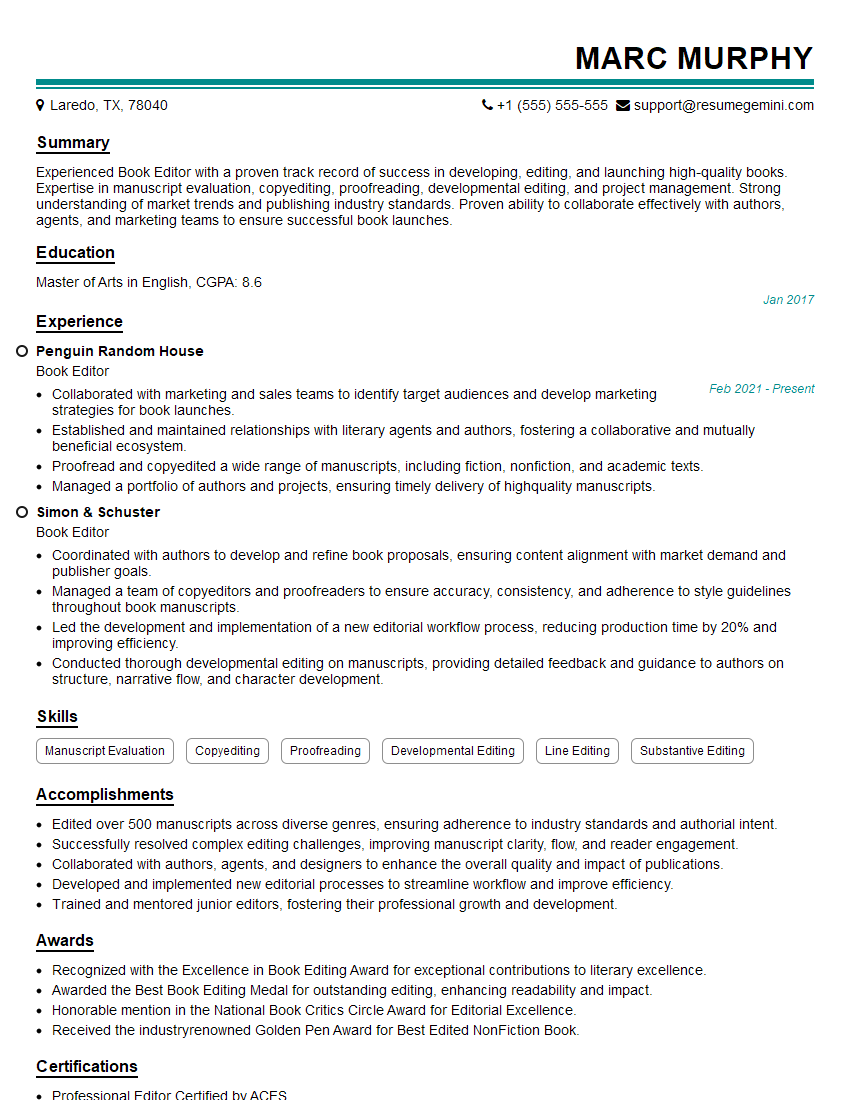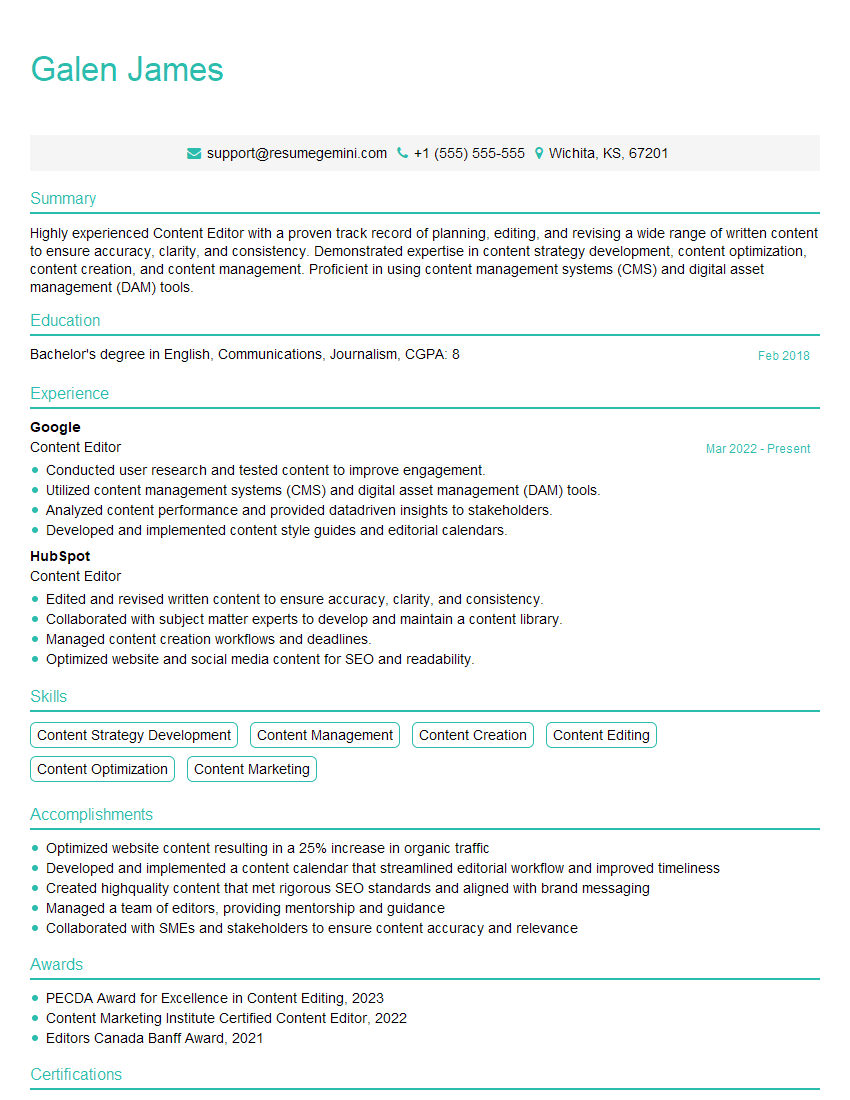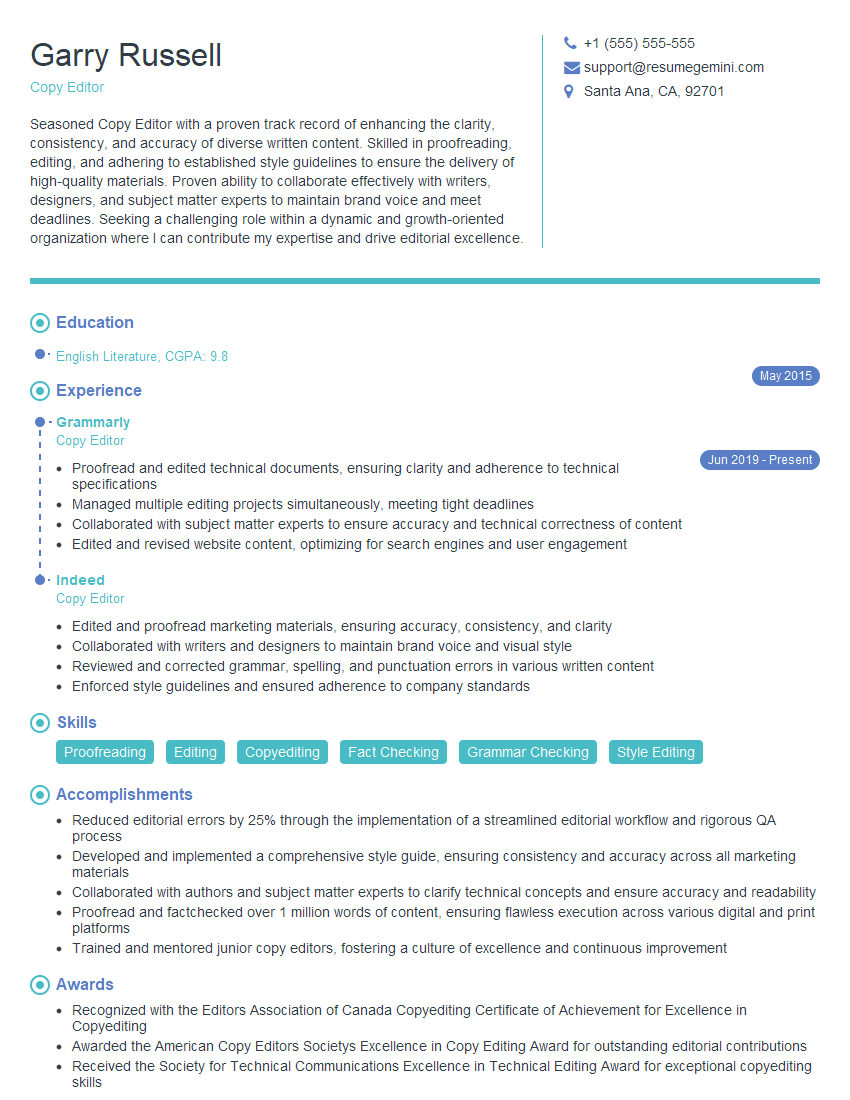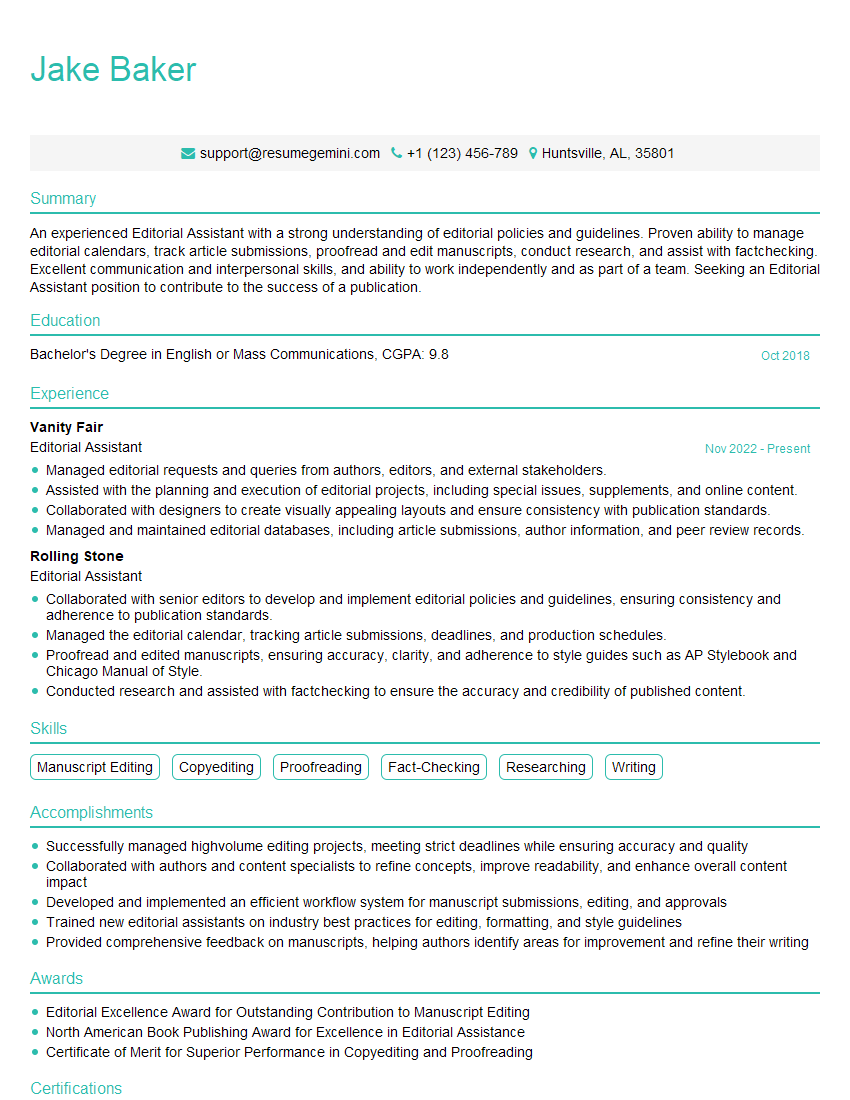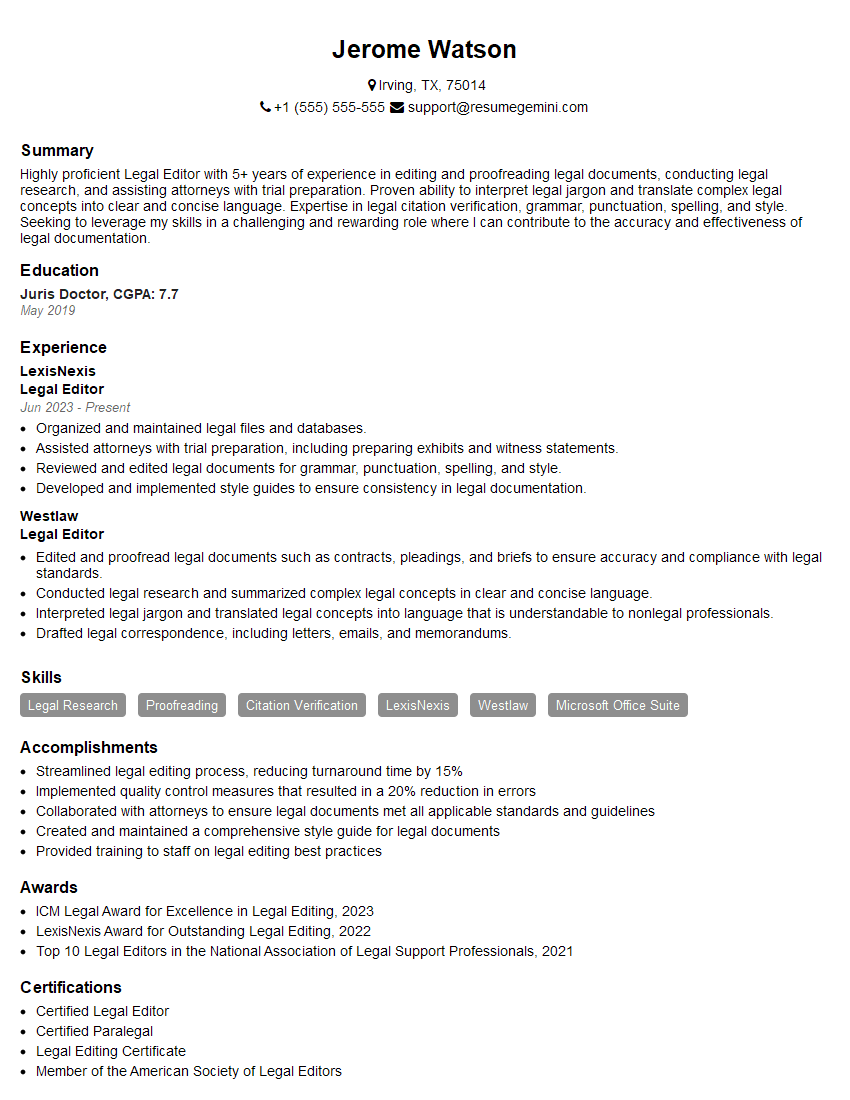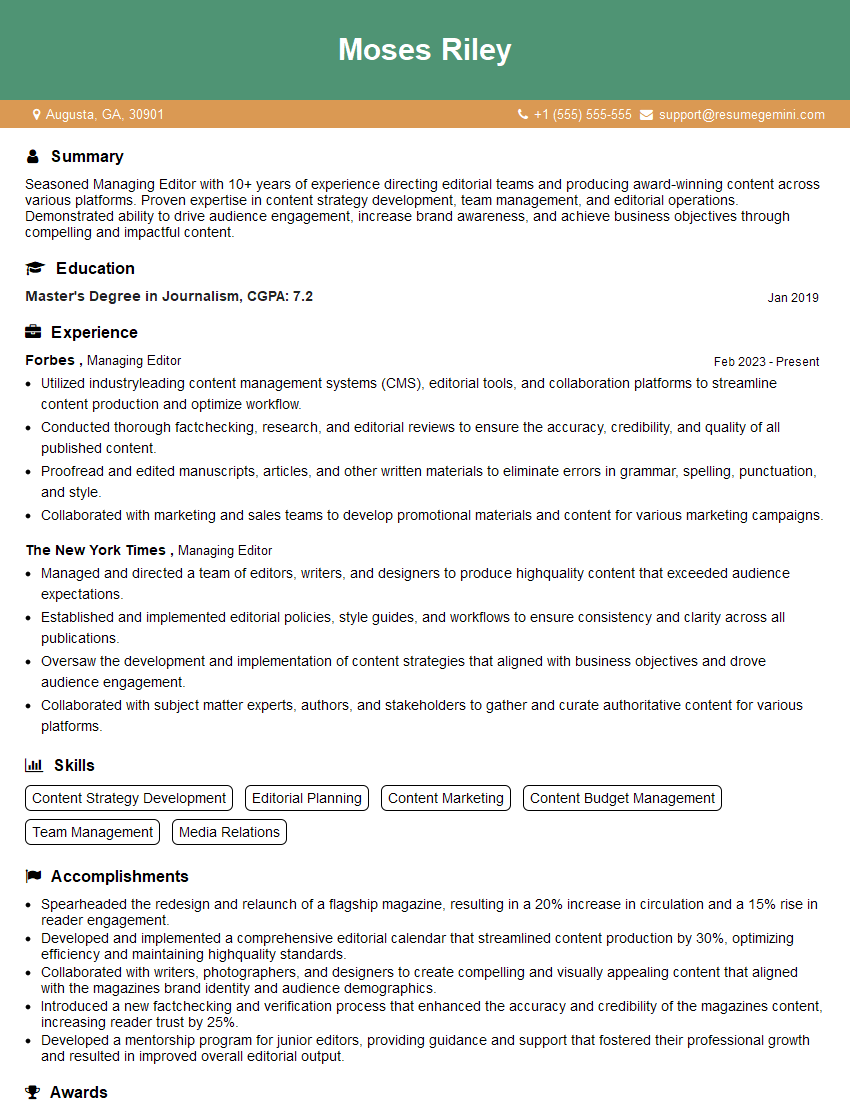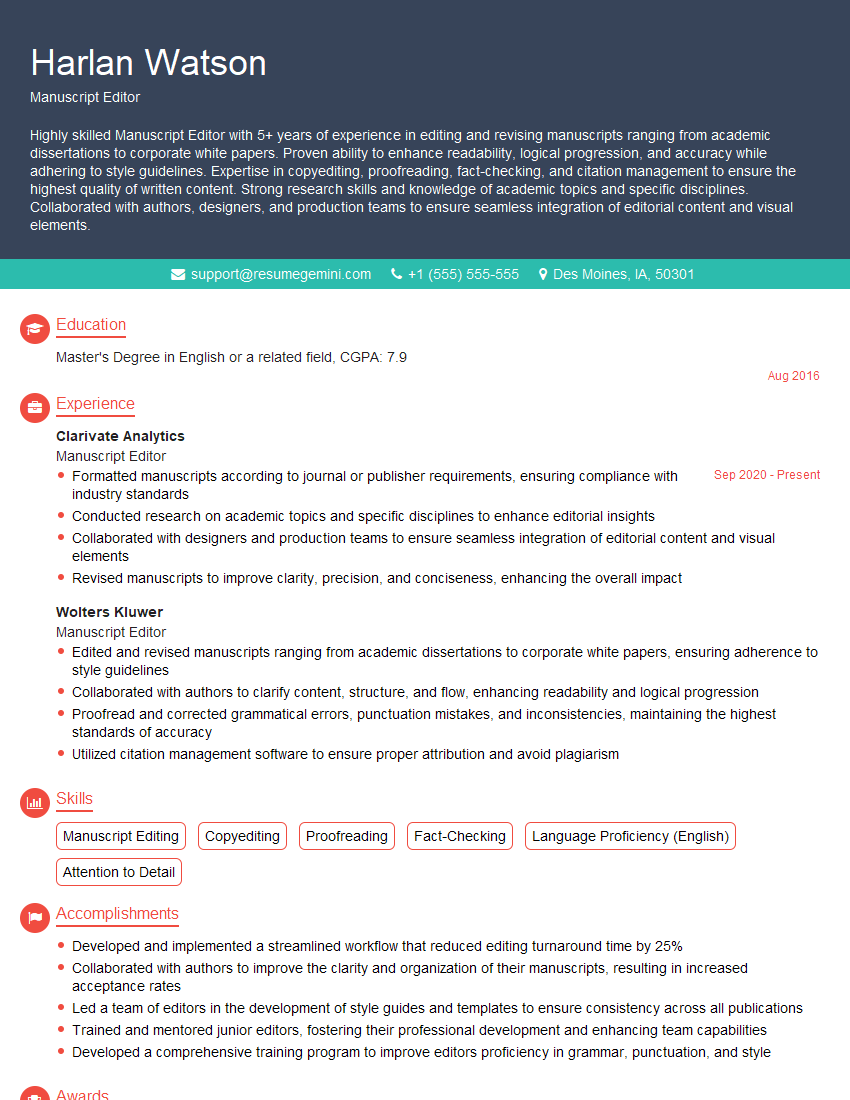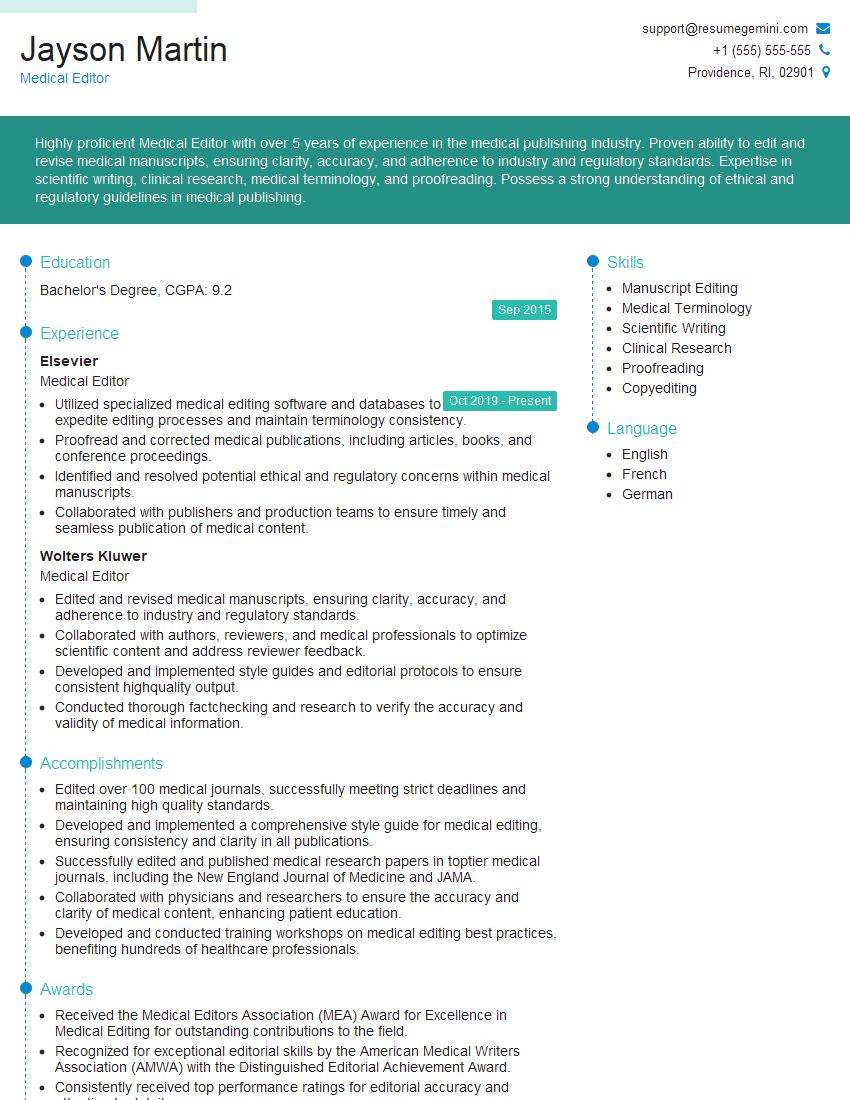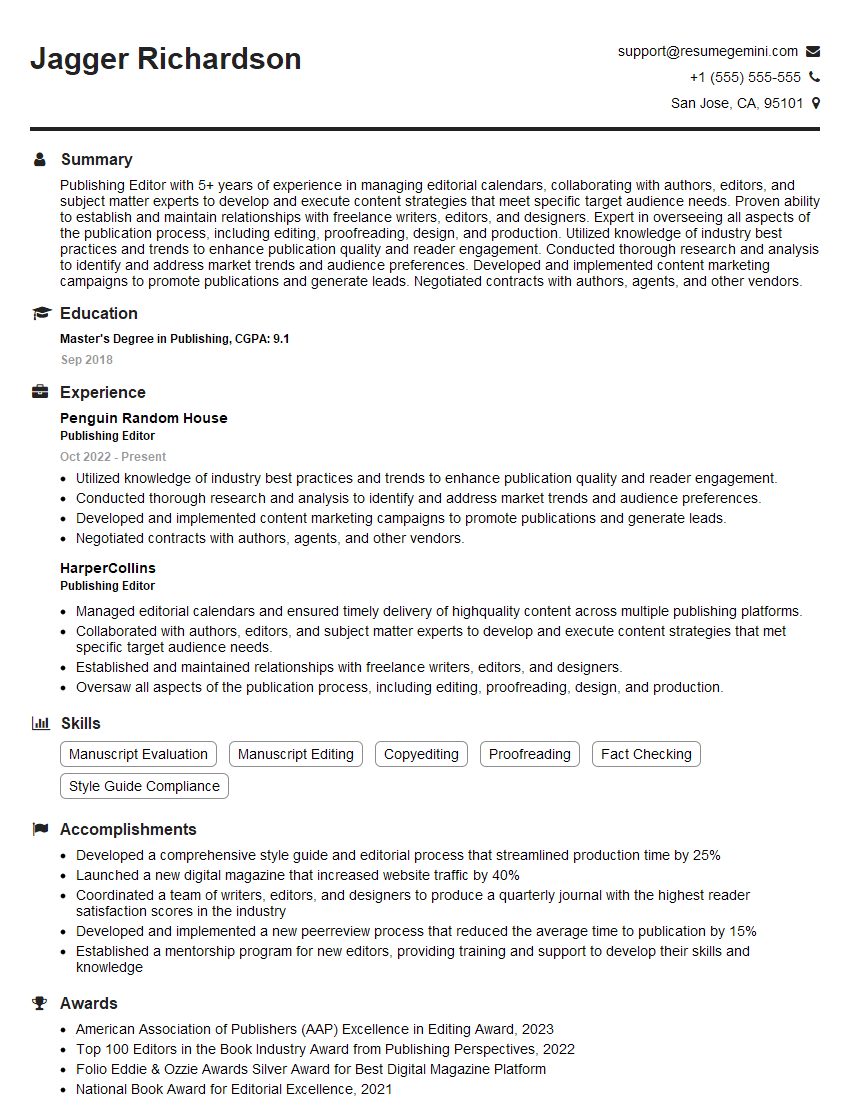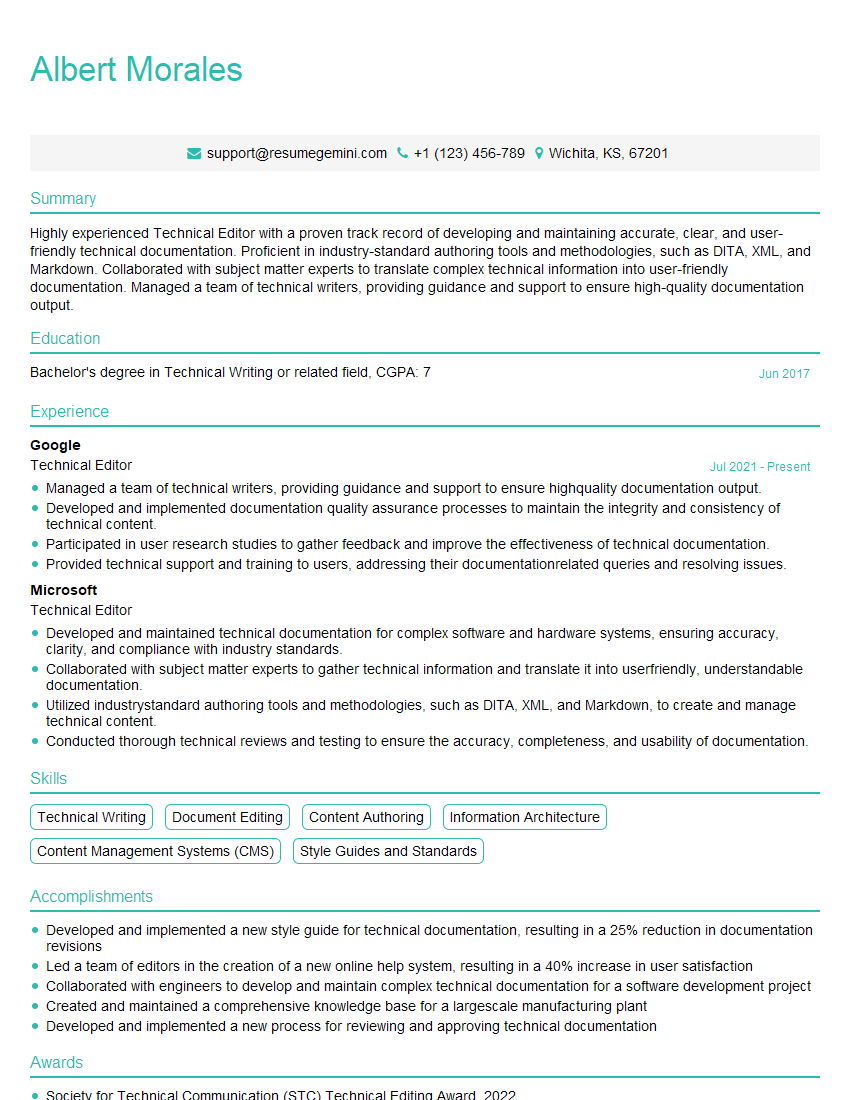Unlock your full potential by mastering the most common Freelance Editing interview questions. This blog offers a deep dive into the critical topics, ensuring you’re not only prepared to answer but to excel. With these insights, you’ll approach your interview with clarity and confidence.
Questions Asked in Freelance Editing Interview
Q 1. What editing styles (e.g., Chicago, AP) are you proficient in?
I’m proficient in several editing styles, most notably Chicago and AP styles. These are widely used and represent different approaches to formatting and style. The Chicago Manual of Style is often preferred for academic and scholarly works, emphasizing footnotes and endnotes, while the Associated Press Stylebook is the standard for journalism and news writing, prioritizing brevity and clarity. My experience extends to applying these styles consistently and accurately across diverse projects, from lengthy academic papers to concise news articles. I’m also adept at adapting to other style guides, as each project often requires adherence to specific guidelines provided by the client.
For instance, I recently edited a historical biography that required adherence to the Chicago style, meticulously formatting citations and ensuring consistent use of capitalization and punctuation. Another project, a press release for a tech company, required precise adherence to AP style guidelines, including abbreviation rules and formatting for datelines.
Q 2. Describe your experience with style guides.
My experience with style guides goes beyond simply knowing the rules; it’s about understanding their underlying principles. I’m skilled in not only applying style guides but also interpreting and adapting them when necessary. I approach each style guide as a tool, recognizing that strict adherence isn’t always possible or appropriate in every context. Flexibility is key—I can navigate situations where inconsistencies exist within a single document or when a style guide needs to be adapted slightly to fit the unique needs of a project. I’m comfortable using both print and online versions of style guides and actively seek out updates to remain current with any changes.
For example, I once worked on a manuscript where the author preferred a slightly different formatting for headings than what was strictly dictated by the chosen style guide. After discussing the implications with the author, we arrived at a compromise that maintained stylistic consistency while respecting the author’s preferences, which in turn enhanced their engagement in the editing process. This kind of collaboration is often vital for ensuring a seamless and satisfactory project outcome.
Q 3. How do you handle conflicting deadlines?
Conflicting deadlines are a reality in freelance editing. My approach is proactive and involves open communication. First, I carefully analyze all deadlines, prioritizing the most urgent ones. Then, I communicate transparently with my clients, explaining the potential challenges and proposing solutions. This might involve adjusting the scope of work, negotiating adjusted deadlines, or prioritizing tasks based on urgency and impact. Sometimes, it means politely declining additional work if taking it on would compromise the quality of existing projects.
Think of it like juggling. You wouldn’t try to juggle five balls at once if you know you’re likely to drop some. Similarly, I assess my workload and manage expectations to avoid burnout and deliver high-quality work consistently. Detailed project planning and time management are essential to successfully navigating conflicting deadlines.
Q 4. How do you prioritize tasks when working on multiple projects?
Prioritizing tasks with multiple projects involves a combination of factors: urgency, complexity, and client importance. I use a project management system, often a simple to-do list or a more sophisticated project management software, to keep track of deadlines and tasks. I break down larger projects into smaller, manageable chunks, making it easier to track progress and allocate time effectively. Tasks with the closest deadlines or the highest potential impact are given top priority.
For instance, if I have a short deadline for a crucial section of a book manuscript alongside a longer deadline for a less critical article, I would focus on the book section first, ensuring timely completion to meet the client’s expectations. This approach ensures that I consistently meet deadlines and deliver projects according to agreed-upon timelines.
Q 5. Explain your process for proofreading a document.
My proofreading process is meticulous and follows a structured approach. I typically take a break after editing before starting the proofreading process for a fresh perspective. I start by performing a comprehensive review of the entire document, carefully examining each sentence for any remaining errors in grammar, punctuation, spelling, and style. This first pass allows me to catch inconsistencies or larger structural errors. I then conduct a second pass, focusing on smaller details like typographical errors and ensuring formatting consistency.
Sometimes, I will read the document aloud to catch errors that my eyes might miss. I use a checklist to make sure I cover all aspects of proofreading, and often utilize digital tools to help with stylistic consistency and finding errors I might otherwise overlook. It’s a two-pronged approach: a big-picture review followed by a detailed line-by-line check. Think of it like house cleaning – you’d first do a general tidy-up and then do a detailed dusting and vacuuming.
Q 6. How do you identify and correct grammatical errors?
Identifying and correcting grammatical errors relies on a strong understanding of grammar rules and consistent attention to detail. I approach this systematically, checking for common errors like subject-verb agreement, pronoun agreement, tense consistency, and correct usage of articles and prepositions. I use a combination of knowledge and tools. My knowledge provides an understanding of the underlying grammatical rules. Tools such as grammar checkers can be helpful but shouldn’t be relied upon solely.
For example, if I encounter a sentence with a subject-verb disagreement such as “The dogs runs in the park,” I would immediately correct it to “The dogs run in the park.” Similarly, I’d identify and correct misuse of pronouns and ensure the consistent use of the appropriate tense throughout the document. My focus is not just on correcting the errors, but also on understanding why the error occurred in order to provide effective feedback to the client.
Q 7. What strategies do you use for fact-checking?
Fact-checking is crucial for maintaining credibility. My approach involves verifying information from multiple, reliable sources. I don’t rely on a single source; instead, I cross-reference information using reputable websites, academic journals, books, and other authoritative sources. I carefully evaluate the credibility of each source, considering its reputation, potential biases, and the date of publication. For highly specific claims, I may consult experts in relevant fields.
Imagine trying to build a house on a weak foundation; it’s bound to collapse. Similarly, inaccurate facts undermine the credibility of any piece of writing. Therefore, I’m diligent about verifying information to ensure accuracy and reliability, providing the client with a document they can trust.
Q 8. How do you handle feedback from clients?
Handling client feedback is crucial for success as a freelance editor. My approach is multifaceted and focuses on clear communication and a collaborative spirit. I always acknowledge receipt of feedback promptly, thanking the client for their input. Then, I carefully review each comment, considering its validity and impact on the overall piece.
For constructive criticism, I analyze the suggestions and implement changes where appropriate, explaining my reasoning behind any modifications or decisions not to implement a specific suggestion. For example, if a client requests a change that contradicts style guidelines or established facts, I’ll politely explain the rationale and suggest an alternative approach. For instance, if they request changing established facts I explain the importance of accuracy in that context.
If the feedback is unclear or contradictory, I initiate a dialogue with the client. I might ask clarifying questions such as: “Could you elaborate on what you mean by…” or “I’m having trouble understanding this suggestion. Could you provide an example?” This proactive communication ensures we’re both on the same page and avoids costly revisions later on.
Q 9. Describe your experience using track changes.
Track changes is an indispensable tool in my editing arsenal. I’m highly proficient in using it across various word processing programs like Microsoft Word and Google Docs. I find it invaluable for maintaining a clear audit trail of all edits, ensuring transparency and accountability. It allows clients to see exactly what changes I’ve made, why I’ve made them, and gives them the opportunity to accept or reject individual edits.
I consistently use track changes to highlight grammatical errors, stylistic inconsistencies, factual inaccuracies, and suggested improvements in sentence structure and clarity. I also utilize the commenting feature to explain my rationale behind certain revisions, addressing potential client questions proactively. For example, if I change a word because of its connotative meaning, I will add a comment explaining my reasoning. This makes the review process smoother and more efficient. I make sure my tracked changes are organized and easy for the client to review.
Q 10. How do you ensure consistency in style and tone throughout a document?
Maintaining consistency in style and tone is paramount for producing professional-quality documents. My process begins with a thorough review of the client’s style guide or, if one doesn’t exist, establishing a consistent style based on the document’s purpose and intended audience. This includes decisions about punctuation, capitalization, formatting, and tone.
I use a combination of techniques to ensure consistency: I create a style sheet that acts as a reference point throughout the editing process, documenting decisions on things like acronym usage, formatting of headings, and preferred terminology. For example, if a client is using a mix of American and British spellings, I make a decision early on, record this in the style sheet and apply the same standard throughout.
I utilize the ‘Find and Replace’ function in word processing software to quickly and accurately implement consistent changes throughout the document. Finally, I conduct a final read-through specifically focused on style and tone to catch any lingering inconsistencies. Regular style check with a style guide is essential.
Q 11. What software and tools do you use for editing?
My editing workflow relies on a suite of software and tools to maximize efficiency and quality. My core software includes Microsoft Word, Google Docs, and Adobe Acrobat Pro. Microsoft Word’s track changes feature is essential, while Google Docs facilitates seamless collaboration. Adobe Acrobat Pro allows me to work with PDFs efficiently and is my go-to tool for editing complex documents.
Beyond these mainstays, I leverage Grammarly and ProWritingAid for automated grammar and style checks. These tools are invaluable for catching errors and suggesting improvements that might otherwise be missed. However, I emphasize that these are aids, not replacements for my judgment and expertise. I always review and edit the suggestions provided by these programs; I treat them as suggestions only. Additionally, I use a dedicated project management tool, like Asana or Trello, to keep track of deadlines and client communication effectively.
Q 12. How do you manage your time effectively as a freelance editor?
Time management is critical for freelance editors, as we juggle multiple projects and deadlines. My strategy is built around careful planning and prioritization. I use a project management tool to create detailed schedules, breaking down large projects into smaller, manageable tasks with realistic deadlines. I allocate specific time blocks in my day for focused work on each project, minimizing distractions.
I employ the Pomodoro Technique, working in focused bursts with short breaks, to maintain concentration and avoid burnout. Furthermore, I communicate proactively with clients to clarify expectations and deadlines, which helps to prevent unforeseen delays and conflicts. Over-promising and under-delivering is a big no-no. I will always set realistic deadlines.
Regularly reviewing my schedule and adjusting priorities as needed is vital. Flexibility is key to managing unexpected delays or urgent tasks. Building in buffer time for unforeseen issues prevents stress and ensures project completion.
Q 13. Describe your experience with different types of editing (copy, line, substantive).
My experience encompasses all three major types of editing: copy editing, line editing, and substantive editing. Copy editing focuses on surface-level errors such as grammar, punctuation, spelling, and consistency. I meticulously proofread text, ensuring accuracy and adherence to style guides. An example would be correcting spelling mistakes, ensuring consistent hyphenation, and verifying fact accuracy.
Line editing delves slightly deeper, focusing on sentence structure, word choice, and flow. I improve clarity and readability by suggesting sentence improvements, refining word choices, and enhancing the overall flow of text. This might involve restructuring sentences to improve clarity and replacing weak verbs with stronger alternatives.
Substantive editing is the most comprehensive level, addressing content, organization, and argumentation. Here, I focus on improving the overall structure of the document, ensuring logical flow of arguments, and assessing the overall strength of the ideas. This might involve re-organizing paragraphs or sections, suggesting additional research, or even suggesting significant changes to the overall argument.
Q 14. How do you handle ambiguous or unclear instructions from a client?
Dealing with ambiguous instructions requires proactive communication and a problem-solving approach. When a client’s instructions are unclear, I don’t hesitate to seek clarification. This prevents misunderstandings and ensures I deliver the desired outcome.
My approach is to politely ask the client for further detail. For example, if the client asks me to “improve the tone” I would ask, “Could you please provide specific examples of what you’d like to see changed in the tone?” or “What is the intended audience for this piece? Knowing the audience would help me tailor the tone appropriately.”
If the instructions remain unclear after my attempt at clarification, I provide a proposed solution and get the client’s approval before proceeding. This collaborative approach minimizes misinterpretations and creates a positive working relationship. I believe in transparency. I would explain why I made the decisions I did and give the client the opportunity to provide further feedback. If this doesn’t work, then I will politely explain to the client that I need additional clarity.
Q 15. What is your preferred method for communicating with clients?
My preferred method for communicating with clients is multifaceted and tailored to their preference. I primarily use email for formal communication and project updates, ensuring a clear paper trail. For quick questions or real-time feedback, I readily utilize instant messaging platforms like Slack or even a quick phone call if the situation calls for it. This approach maintains professionalism while fostering a collaborative and efficient workflow. I believe open and proactive communication is key to a successful client relationship, so I always keep them informed of my progress and any potential roadblocks.
For example, I’ll often send a brief email summarizing our discussion after a phone call to ensure we’re both on the same page regarding next steps. This avoids misunderstandings and keeps things organized.
Career Expert Tips:
- Ace those interviews! Prepare effectively by reviewing the Top 50 Most Common Interview Questions on ResumeGemini.
- Navigate your job search with confidence! Explore a wide range of Career Tips on ResumeGemini. Learn about common challenges and recommendations to overcome them.
- Craft the perfect resume! Master the Art of Resume Writing with ResumeGemini’s guide. Showcase your unique qualifications and achievements effectively.
- Don’t miss out on holiday savings! Build your dream resume with ResumeGemini’s ATS optimized templates.
Q 16. How do you maintain client confidentiality?
Client confidentiality is paramount. I adhere to strict professional ethics and utilize secure communication channels. All client documents are stored on password-protected devices and cloud storage services with robust encryption. I never share client information with third parties without explicit written consent. Furthermore, I always treat any proprietary information I encounter as strictly confidential. Even after a project is completed, client data remains secure and is archived according to best practices. My commitment to confidentiality is not just a professional obligation; it’s a core value.
Q 17. What is your process for quoting and invoicing clients?
My quoting process begins with a thorough understanding of the client’s needs. This involves a detailed discussion of the project scope, word count, type of editing required (copyediting, proofreading, substantive editing), and turnaround time. I then provide a clear and itemized quote, outlining the cost per word or hour, any additional charges (e.g., expedited service), and the payment schedule. My invoices are equally detailed, specifying the services rendered, the agreed-upon rate, and payment terms. I generally use invoicing software that allows for easy tracking and client communication.
For example, if the client needs a rush job, I’ll clearly state the additional fee for expedited service in my quote and invoice. This transparency ensures there are no unexpected costs.
Q 18. How do you handle difficult or demanding clients?
Handling difficult clients requires patience, empathy, and clear communication. My approach focuses on actively listening to their concerns and addressing them professionally. I strive to understand their perspective, even if I don’t agree with it. I clearly define expectations from the outset, providing detailed project timelines and communication protocols to mitigate potential misunderstandings. If a conflict arises, I document everything, maintaining a calm and professional tone in all communications. If necessary, I’ll outline potential solutions collaboratively, ensuring a mutually agreeable outcome. Sometimes, setting firm boundaries is essential to protect my well-being and maintain professional integrity. If a situation is irreconcilable, I may choose not to continue working with the client.
For example, I once had a client who was consistently changing their mind on aspects of the project. I responded by creating a document outlining the agreed-upon revisions and providing a clear process for requesting further changes, which calmed the situation considerably.
Q 19. How do you stay up-to-date on current grammar and style rules?
Staying current on grammar and style rules is crucial for any editor. I subscribe to professional editing resources such as the Chicago Manual of Style, the Associated Press Stylebook, and reputable online grammar guides. I also participate in professional development opportunities such as webinars and workshops offered by editing associations. Regularly reviewing style guides, participating in online forums, and engaging with other professionals in the field helps me remain abreast of evolving standards and best practices. Continuous learning ensures that I provide consistently high-quality editing services.
Q 20. Describe a time you had to meet a tight deadline under pressure.
I once had to edit a 50,000-word manuscript with a deadline of just three days. To meet this tight deadline, I utilized time management techniques such as breaking the task into smaller, manageable chunks, prioritizing the most crucial areas first, and working extended hours. I also leveraged technology to streamline the process – using grammar-checking software to speed up certain stages while maintaining my quality control. Despite the pressure, I delivered a high-quality edited manuscript on time, thanks to careful planning and efficient work habits.
Q 21. How do you deal with conflicting feedback from multiple reviewers?
Conflicting feedback from multiple reviewers requires a thoughtful and diplomatic approach. My process involves carefully analyzing all feedback, identifying areas of agreement and disagreement. I prioritize feedback from reviewers with relevant expertise or those who are deeply familiar with the client’s target audience. For conflicting points, I might reach out to the reviewers to clarify their concerns, or if that’s not feasible, I carefully weigh the evidence and justify my decisions in a concise explanation to the client. My goal is to present a final product that is consistent with the overall project goals and meets the client’s needs, while respecting the expertise and input of all reviewers involved.
Q 22. How do you handle edits that may change the author’s intended meaning?
Preserving an author’s intended meaning is paramount in freelance editing. If an edit alters the core message, it’s a significant error. I approach this by meticulously analyzing the context. Instead of simply correcting grammar or style, I consider the overall argument and the author’s tone.
For instance, if an author uses a slightly informal tone for a specific effect, I wouldn’t force overly formal language. If a sentence is grammatically incorrect but conveys the meaning accurately, I might rephrase it subtly to improve clarity without changing the core idea.
My process involves careful questioning. If I’m unsure about a particular phrase’s meaning or intent, I contact the author for clarification before making any changes. This collaborative approach ensures that edits enhance, rather than detract from, the original work.
Q 23. Explain your understanding of plagiarism and how you avoid it.
Plagiarism is the act of presenting someone else’s work or ideas as your own. It’s a serious breach of ethics and can have severe consequences. As a freelance editor, I rigorously avoid plagiarism by always properly citing sources. If I encounter text that seems suspicious, I investigate its origins thoroughly.
My workflow includes using plagiarism detection software on all texts before and after editing. Furthermore, I maintain meticulous records of all sources consulted, ensuring complete transparency and preventing accidental plagiarism. If I need to incorporate information from another source, I paraphrase it carefully, ensuring I’m not simply rewording; I’m truly summarizing and synthesizing the information in my own words, followed by a citation.
Q 24. How do you handle large volumes of text to be edited efficiently?
Editing large volumes of text efficiently requires a strategic approach. I break down the task into manageable chunks. This might involve focusing on one chapter or section at a time, or dividing the document into smaller thematic units.
I use tools that enhance my efficiency, such as style guides, macros in word processing software for repetitive tasks, and text-editing software with advanced features like search and replace. I also prioritize my edits. For instance, I might tackle major structural issues first, then move on to grammar and stylistic elements.
Taking regular breaks is crucial to avoid burnout and maintain accuracy. I often use a timer technique – working for a set period, then taking a short break to rest my eyes and mind. This structured approach allows me to maintain focus and consistency while handling large documents.
Q 25. What are your rates for various editing services?
My rates are project-dependent and vary based on several factors, including the length of the document, the complexity of the edit, the turnaround time, and the type of editing required.
I offer different levels of editing:
- Copyediting: Focuses on grammar, mechanics, style, and consistency. My rates typically start at [Insert Rate/Page or/Word], depending on the project details.
- Proofreading: Checks for typos, grammatical errors, and inconsistencies. Rates are generally lower than copyediting, starting around [Insert Rate/Page or/Word].
- Developmental Editing: Addresses the overall structure, organization, and argument of the work. Rates for this in-depth process are higher, starting at [Insert Rate/Project or/Hour].
A detailed quote is always provided after a thorough review of the document and project requirements.
Q 26. How do you determine the scope of work for a project?
Determining the scope of work involves a thorough communication process with the author. It begins with a clear understanding of the author’s goals for the project. This usually involves a discussion to understand the target audience, the intended message, and the desired tone of the writing.
I then review a sample of the text to assess the overall quality and identify areas requiring attention. A crucial aspect of scope definition is agreeing on the type of editing needed (copyediting, proofreading, developmental editing). We clarify the expected deliverables, such as revisions and turnaround time.
Finally, I’ll provide a detailed proposal outlining the scope of work, including estimated timelines, specific services offered, and the total cost. This ensures everyone is on the same page and avoids misunderstandings during the project.
Q 27. What is your experience with different file formats?
I’m proficient in handling a variety of file formats commonly used in writing and publishing. This includes:
.docand.docx(Microsoft Word).rtf(Rich Text Format).pdf(Portable Document Format).txt(Plain Text).odt(OpenDocument Text)
My familiarity with these formats ensures seamless collaboration with authors regardless of their preferred software. I can readily convert between formats as needed and ensure the integrity of the document throughout the editing process.
Q 28. Describe a challenging editing project and how you overcame the challenges.
One challenging project involved a complex academic manuscript with inconsistent formatting, extensive jargon, and a weak argument structure. The author, a renowned expert in their field, had difficulty articulating their research clearly for a wider audience.
I overcame the challenges by employing a multi-stage approach. First, I created a style guide to ensure consistency. Then, I worked closely with the author to clarify their central argument and restructure the manuscript for improved flow. This involved significant rewriting and the simplification of technical jargon to make the text accessible.
I also employed collaborative editing tools that allowed the author and I to work on the document simultaneously. This ensured transparency, facilitated quick feedback, and allowed us to solve problems efficiently. The result was a significantly improved manuscript that was both academically rigorous and accessible to a broader readership. The project was ultimately successful due to a commitment to clear communication and a collaborative editing approach.
Key Topics to Learn for Your Freelance Editing Interview
- Understanding Different Editing Styles: Learn the nuances of copyediting, proofreading, developmental editing, and substantive editing. Be prepared to discuss the specific tasks involved in each and when they are most appropriate.
- Grammar and Mechanics Mastery: Demonstrate a deep understanding of grammar rules, punctuation, style guides (AP, Chicago, etc.), and common grammatical errors. Practice applying these rules consistently and accurately.
- Working with Style Guides and Client Preferences: Explain your experience adapting to various style guides and adhering to client-specific requirements. Be ready to discuss how you manage conflicting styles or unclear instructions.
- Time Management and Project Prioritization: Freelance editing often involves juggling multiple projects with tight deadlines. Highlight your skills in effective time management, task prioritization, and meeting deadlines consistently.
- Using Editing Software and Tools: Showcase familiarity with common editing tools (e.g., Microsoft Word’s Track Changes, grammar checkers). Discuss your proficiency and how these tools improve your workflow.
- Client Communication and Professionalism: Describe your approach to communicating with clients, handling feedback, and managing expectations. Emphasize your professionalism and ability to build strong working relationships.
- Understanding Copyright and Legal Considerations: Demonstrate awareness of copyright law and ethical considerations related to editing and plagiarism. Discuss how you ensure the integrity and originality of the work you edit.
- Marketing and Self-Promotion (for freelance interviews): Be prepared to discuss your strategies for finding clients, building a portfolio, and marketing your freelance editing services.
Next Steps
Mastering freelance editing opens doors to a flexible and rewarding career, offering diverse opportunities and the chance to work with a variety of clients and projects. To maximize your job prospects, creating an ATS-friendly resume is crucial. An effective resume highlights your skills and experience in a way that Applicant Tracking Systems can easily recognize, leading to more interview invitations. We strongly encourage you to use ResumeGemini to build a professional and impactful resume that showcases your editing expertise. Examples of resumes tailored specifically for freelance editing professionals are available to guide you.
Explore more articles
Users Rating of Our Blogs
Share Your Experience
We value your feedback! Please rate our content and share your thoughts (optional).
What Readers Say About Our Blog
Interesting Article, I liked the depth of knowledge you’ve shared.
Helpful, thanks for sharing.
Hi, I represent a social media marketing agency and liked your blog
Hi, I represent an SEO company that specialises in getting you AI citations and higher rankings on Google. I’d like to offer you a 100% free SEO audit for your website. Would you be interested?

